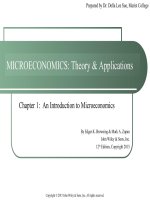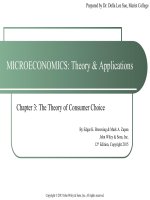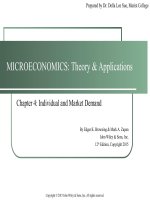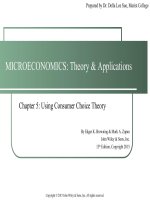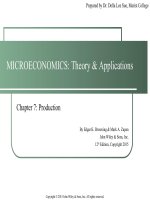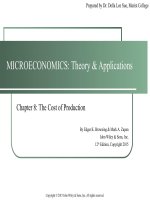MicroEconomics theory and application 12th by browning an zupan chapter 18
Bạn đang xem bản rút gọn của tài liệu. Xem và tải ngay bản đầy đủ của tài liệu tại đây (352.26 KB, 35 trang )
Prepared by Dr. Della Lee Sue, Marist College
MICROECONOMICS: Theory & Applications
Chapter 18: Using Input Market Analysis
By Edgar K. Browning & Mark A. Zupan
John Wiley & Sons, Inc.
12th Edition, Copyright 2015
Copyright © 2015 John Wiley & Sons, Inc. All rights reserved.
Learning Objectives
Analyze the effects of minimum wage on the employment of unskilled
workers.
Determine the extent to which employers versus employees bear the
burden of the Social Security program.
Explore an important hidden cost of Social Security that results from
the program's long-run impact on saving and social accumulation.
(continued)
Copyright © 2015 John Wiley & Sons, Inc. All rights reserved.
2
Learning Objectives
(continued)
Explore the benefits to firms from colluding in hiring an input through
examining the NCAA cartel.
Show how employment discrimination can affect wage rates and
employment.
Outline the benefits and costs of immigration.
Copyright © 2015 John Wiley & Sons, Inc. All rights reserved.
3
Analyze the effects of minimum wage on the employment of unskilled
workers.
18.1 THE MINIMUM WAGE
Copyright © 2015 John Wiley & Sons, Inc. All rights reserved.
4
The Minimum Wage Law
Fair Labor Standards Act
Passed by Congress in 1938
Minimum wage is periodically increased
Consequences depend on magnitude of the legal minimum relative to the
prevailing wage rate in the economy
Disemployment effect – the tendency of employers to respond to a higher wage
rate by hiring fewer workers
Magnitude of unemployment depends upon elasticity of demand and supply
Who bears cost?
Displaced workers
Society – due to higher prices of products produced by covered labor
and to lower prices for products produced by complementary factors of
production
Copyright © 2015 John Wiley & Sons, Inc. All rights reserved.
5
Figure 18.1 - The Minimum Wage
Copyright © 2015 John Wiley & Sons, Inc. All rights reserved.
6
Further Considerations of the Minimum
Wage Law
The reduction in employment can take the form of a reduction in hours
each worker is employed rather than a reduction in the number of
workers employed.
When the government requires firms to pay a higher money wage,
employers will respond, if possible, by reducing fringe benefits of
employment.
The minimum wage law does not cover all unskilled jobs.
With a surplus of workers created by the minimum wage, employers can
be more selective about whom they hire.
Copyright © 2015 John Wiley & Sons, Inc. All rights reserved.
7
Does the Minimum Wage Harm the
Poor?
Objective of minimum wage: help the poor
However:
Low wage earners are in families that are not poor
Most people in poor families who work are paid more
than the minimum wage
Most poor families are poor because they have no
earnings at all
Most of the minimum wage earners live in households
with incomes above the poverty line
Copyright © 2015 John Wiley & Sons, Inc. All rights reserved.
8
Figure 18.2 – The Effects of an Increase
in the Minimum Wage
Cost:
Net income change = Area
W1GFW - Area FBL1L2
Higher prices due to
higher wages (factor input
price)
Copyright © 2015 John Wiley & Sons, Inc. All rights reserved.
9
The Minimum Wage: An Example of an
Efficiency Wage?
Efficiency wage – a wage higher than the prevailing market-determined
level that serves to increase firms’ profits by lowering the costs of
searching for, selecting, and training new workers
Copyright © 2015 John Wiley & Sons, Inc. All rights reserved.
10
Determine the extent to which employers versus employees bear the
burden of the Social Security program.
18.2 WHO REALLY PAYS FOR SOCIAL
SECURITY?
Copyright © 2015 John Wiley & Sons, Inc. All rights reserved.
11
Who Really Pays for Social Security?
The real effects of the tax are the same whether the tax is collected from
employers or employees.
Workers bear most, if not all, of the cost of the tax in the form of
reduced wages.
If income and substitution effects exactly offset each other, the labor
supply curve is vertical.
Vertical labor supply curve => net wage received by workers falls by
the amount of the tax = workers bear entire burden of the tax
Copyright © 2015 John Wiley & Sons, Inc. All rights reserved.
12
Figure 18.3 – Tax on Employers versus
Tax on Employees
Copyright © 2015 John Wiley & Sons, Inc. All rights reserved.
13
Figure 18.4 – The Burden of the Social
Security Tax
Copyright © 2015 John Wiley & Sons, Inc. All rights reserved.
14
Explore an important hidden cost of Social Security that results from the
program's long-run impact on saving and social accumulation.
18.3 THE HIDDEN COSTS OF SOCIAL
SECURITY
Copyright © 2015 John Wiley & Sons, Inc. All rights reserved.
15
The Hidden Cost of Social Security
Pay-as-you-go (PAYGO) basis – retirement benefits are financed from
payroll taxes collected from workers
If workers save less for retirement, there is a reduction in investment
and an increase in the interest rate.
Consequences:
slower growth rate for the economy
level of GDP is lower than it would have been had
Social Security never been implemented
Copyright © 2015 John Wiley & Sons, Inc. All rights reserved.
16
Figure 18.5 – The Effect of Social Security
on Investment and the Interest Rate
Copyright © 2015 John Wiley & Sons, Inc. All rights reserved.
17
Figure 18.6 – The Long-Run Effect of
Social Security on GDP
Copyright © 2015 John Wiley & Sons, Inc. All rights reserved.
18
The Effect on Labor Markets
In addition to the direct effect of paying payroll taxes on earnings due
to PAYGO Social Security:
Capital stock is substantially lower.
Worker productivity is lower.
The demand curve for labor is lower.
The before-tax wage rate is lower.
Copyright © 2015 John Wiley & Sons, Inc. All rights reserved.
19
Figure 18.7 - The Effect of Social
Security on Before-Tax Wage Rates
Copyright © 2015 John Wiley & Sons, Inc. All rights reserved.
20
Explore the benefits to firms from colluding in hiring an input through
examining the NCAA cartel.
18.4 THE NCAA CARTEL
Copyright © 2015 John Wiley & Sons, Inc. All rights reserved.
21
The NCAA Cartel
Cartel incentives in input market:
Limit input use
Lower price paid for the input
Monopsony power
Example: National Collegiate Athletic Association (NCAA)
Copyright © 2015 John Wiley & Sons, Inc. All rights reserved.
22
Figure 18.8 - An Input Buyers’ Cartel
Copyright © 2015 John Wiley & Sons, Inc. All rights reserved.
23
Hindrances to Input Buyers’ Cartels
Firms have an incentive to cheat on the cartel agreement.
Participating firms will find it difficult to reach agreement on the levels
of permitted employment and the wage rate.
The lower wage rate invites entry into the market by other firms that are
not parties to the cartel.
Coordinating hiring decisions among a large number of firms within
and across industries is difficult.
A firm usually hires many different inputs, and the potential profit from
reducing the price of only one input may be small.
Copyright © 2015 John Wiley & Sons, Inc. All rights reserved.
24
The NCAA as a Cartel of Buyers
National Collegiate Athletic Association (NCAA) – a private
organization empowered to regulate various aspects of college athletics
Determines the maximum financial reward a studentathlete can receive
Determines the number of student-athletes who may be
recruited with scholarships at each school
Applies sanctions to punish cheaters who are caught
sanctions have become increasingly severe
Copyright © 2015 John Wiley & Sons, Inc. All rights reserved.
25


